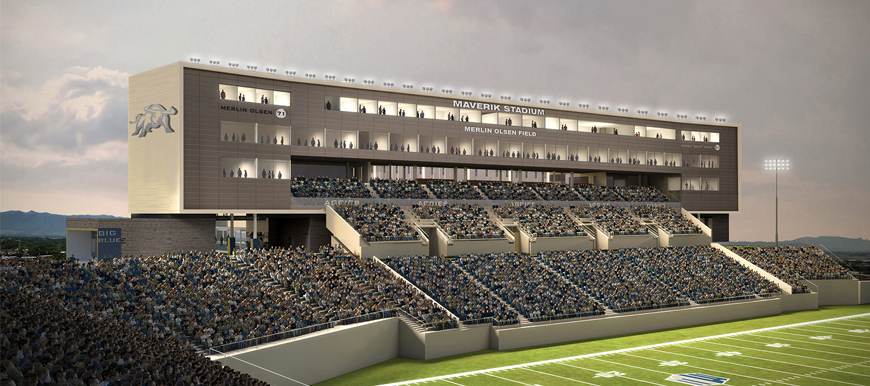It’s official: Maverik named corporate sponsor
The renaming of Romney Stadium to Maverik Stadium became official Saturday afternoon at Utah State University.
Under a tent in the north end of the stadium parking lot, university president Stan Albrecht and Maverik Inc. CEO Tom Welch spoke and shook hands to make the partnership official. The specifics of the contract cannot be released due to business confidentiality.
“What an incredible day,” Albrecht said. “We’ve had a lot of really exciting things going on at Utah State over the last few years and this has to be one of the most exciting. As I have thought a lot about this, what we are celebrating today is the culmination of what could probably be described as a whirlwind romance.”
The event marked the beginning of a long-term naming rights partnership to its football stadium.
“We’re all in blue. We’re just one big family now,” Welch said. “There are those events in life that you want to capture and in my life, today is one of them. Maybe most special, at least when it comes to what I’ve been involved in and what I love, and I love Maverik.”
To go along with its new name, Utah State will also begin a remodeling project to give the venue a face lift. Utah State athletic director and university vice president Scott Barnes spoke about the importance of having a sponsorship and the changes it will bring.
On the west side, a new four-story premium seating and press box structure will be built to include a state-of-the-art media and game operations area, 24 luxury suites, 20 loge boxes, over 700 covered club seats and a premium club area that will also be used to host a student-athlete training table.
Major concourse work will include significantly increased restroom facilities, doubling the amount according to Albrecht, upgraded concessions and an enlarged concourse for better pedestrian traffic flow.
Renovations will also include new video boards on both the north and south ends of the stadium, along with a new public address system. The additional expansion of Maverik Stadium’s seating capacity is also planned for the future. Utah State’s football stadium was constructed 47 years ago and has been altered only four times.
However, the seating capacity has been altered twice. Once, in 1980 with the addition of approximately 10,000 seats to the south bowl, and again in 1997 as roughly 4,000 chair back seats were installed to bring the present capacity to 25,513.
In 2005 the south end zone area was renovated. This gave an upgrade to concessions and restroom facilities, as well as a widened concourse on the east side of the stadium. Lastly in 2008, the three-story, 69,000-square foot Jim and Carol Laub Athletics-Academics Complex was completed in the north end zone, providing enhanced athletic and academic resources for all 16 of USU’s varsity sports.
Mountain West Comissioner Craig Thompson was on hand for the event and he praised Utah State for the progress the university has made in signing with a corporate sponsor.
“What’s good for Utah State is good for the Mountain West,” Thompson said. “This is a great day, and we appreciate your support. Our relationship with Utah State is short, but it’s only beginning.”
The stadium was originally named after the late E. Lowell “Dick” Romney. Romney spent 29 seasons as the Aggies’ athletics director and head football coach from 1919-1948, compiling a 128-91-16 record on the field. Romney also spent 22 seasons,1920-1941, as the men’s basketball coach at USU and posted a 225-157 record. He was the track & field coach for 24 seasons and was the Aggies’ head baseball coach for three years, 1919-1921.
“When you think about where we are today, you can’t help but think about those that came before us,” Barnes said. “Certainly as we transition from Romney Stadium to Maverik Stadium, we have to think about the great E.L. ‘Dick’ Romney.
“Dick was a Hall-of-Fame coach and administrator here. I want to take this time to acknowledge the Romney family. Understand this: Dick Romney’s legacy will continue, and it will continue in a big way inside Maverik Stadium, and we can’t wait to continue and further plan for that.”
Romney’s grandson, Richard Romney, was at the renaming ceremony with his family to help remember his grandfather.
“The renaming of Romney Stadium is a little bittersweet,” Richard Romney said. “Our family realizes that to be competitive and relevant in today’s sports world, you need to have the financial backing of corporate America. … What grandpa accomplished at Utah State will never be duplicated in today’s society. We know his name will remain prominent and continue to have a strong legacy at Utah State. His story will not be forgotten.”
In all, Dick Romney is the longest-tenured head football and basketball coach in school history as well as the longest-tenured athletics director. He also ranks first all-time in career football wins with 128 and football games coached 235.
While Romney Stadium is no more, those present Saturday believe that the renaming will help Utah State move forward.
“We’ve had a lot of special things happen at Utah State throughout the years,” Albrecht said. “This will certainly be one of the most important, thanks to our Maverik partners. You saw that plane that was going around with the sign reading, ‘Maverik Loves Utah State.’ Well, Utah State loves Maverik, too.”
— kalen.s.taylor@gmail.com
Twitter: @kalen_taylor

